#uzbek suzani
Explore tagged Tumblr posts
Text

Uzbek Suzani embroidered with pomegranates.
1K notes
·
View notes
Photo




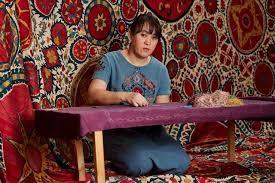
Royal Suzani tapestry, size is 20’ - 14’ (6 х 4.12 m), embroidery master Madina Kasimbaeva, Uzbekistan.
Suzane translated from Farsi means "Needle" - embroidered with a needle. The suzane embroidered by Madina Kasimbaeva belongs to the Shakhrisabz region "Shakhrisabz, lakai."
From the exhibition ‘The Birth of Suzani’, which explored the traditional art of Uzbek embroidery was in Tashkent, Uzbekistan a few months ago.
https://www.selvedge.org/.../norway-ingunn-undrum-sarah...
18 notes
·
View notes
Text

Antique urban suzani from the Emirate of Bukhara created by the Lakai, a rural Uzbek people, in the late 19th and early 20th centuries.
source: HALI 215
pwlanier via semtituloh
7 notes
·
View notes
Text
Day 68 - 12 November - Samarkand
Woke up quite late after a big day the day before. The breakfast in the new hotel was not very good and we were slightly scratching at what to eat, I had lots of pancakes with nutella which is not the basis of a balanced diet. We mobilised and walked round and got some boxes to send the things we had bought in the market back to the UK. We got a couple from shops, the one we ended up using had previously housed tea imported from Kenya with the great name for an Uzbek company of Amir Tea. With the box we then went to the market to look around, we actually were found by one of the ladies from the market on Sunday who had a stall in the bazar and awkwardly had to say we didn’t want any more suzani.
We went back to hotel and packed the box. We put a couple of other things in the box we didn’t want to carry or were finished using. We went to dhl who quoted £275 to ship which we balked at. We then took Yandex to a post office and had a very interesting experience waiting in a slightly chaotic queue with ladies sending care packages, often involving cigarettes. The lady in the post office put our box in a hessian sack and we wrote our address on top of it. It was lots cheaper than the DHL price thankfully.

We then went to this well reviewed restaurant further out (it seems that lots of the real life of Samarkand happens quite far out of town) which specialised in shish kababs which were very nice. We had a very sweet waiter who was very keen to speak English when he found out where we were from and who came to speak to us when he found an excuse to serve us. He said he was Persian, which I took for Tajik which is possibly the majority ethnicity in Samarkand even though the census says majority Uzbek, as many Persian speakers were classified as Uzbek in soviet times. After that we took a yandex to this pub near the Registan. There is an English couple who seem to be doing an almost identical trip round Uzbekistan who we have seen on the train to Khiva, in Bukhara and then we walked past in the street (we see lots of the same tourists at the main sites as it is low season and there are really clear sights to see). They then came into the empty pub when were there, although they sat in a different place to us. After our drink we walked back home and went to bed.

Day 69 - 13 November - Samarkand > Tashkent
We woke up to the sound of rain, which was unexpected. It has been cold but I didn’t think it really rained here but I guess it does! We checked out and went to the Afrosyab museum, that deals with the pre Islamic history of Samarkand (mainly Sogdian) It was quite interesting but very like lots of the museums we have been to. We then to Ulug-Beg Observatory which was very small but had a little exhibit on Ulug’s scientific work and then the remains of a big part of the observatory sextet but not a lot else (it was cool though!) Before we joked about seeing the English couple and they were there again!

We went to art café norgis again for lunch we we wanted some veg. After, we asked around for a bit and got our bags and went to the station for our train. The train was very comfortable and made the ground very quickly.
When we got to Tashkent, it was sleeting and was very cold but also quite atmospheric. We got the metro to Kosmonavtlar metro that was an amazing station with murals of kosmonauts on it. We checked into the hotel and immediately hot footed it to the bus station to book our bus to Bishkek. The station was about half an hour on the metro and when we had booked it was getting a bit late. We went to the food court of this mall and had a rather nice light meal before hopping on the metro home again and going to bed.






Day 70 - 14 November - Tashkent > Bishkek
We got up and went to the gym in the hotel before breakfast. Then checked out and got some photos taken for our Indian visa. We then went to a cafe and applied for the Indian visa which was possibly the most stressful thing we have done on the trip so far. The site is glitchy and they ask for loads of information, it took us a couple of hours before we submitted. A bit shell shocked we went to get lunch at this Korean place we had seen the last time we were in Tashkent. It was very tasty and we were nice a full getting ready for our 14 hour bus!
We went to the bus station and got on the bus in plenty of time. The bus beside us had beds and looked pretty lush, ours was a normal old coach. We had changed some money in the station so we had Kazakh money for when were across the border (the route to Bishkek goes through Kazakhstan as its the fastest way).
We t the bus for about an hour till we got to the border. We got off, there was no signage and they hadn’t told us where the busses clicked you up. We went on a long walk through railings corridors to the exit point, there was lots of queue jumping in exit queue but we managed to get through. It was then another long walk to the entry gates and with the cold and the dark and the bright lights it felt unite cinematic. At passport control the border officer looked at my passport, got up and asked someone about Irish visa reqs which for a second made me fear I had got it wrong and that i needed a visa! However he sat down, stamped the passport and asked me lean in when he gave me my passport back. He then said ‘welcome to Kazakhstan’ in a very friendly voice and I immediately relaxed., Going through the next door, showing my stamp, another soldier saw my passport and then said ‘ahh! Conor McGregor!’, which I guess I should thank The Notorious for, even if he’s the blurst!

We got through the gates into the cold and then couldn’t find the bus! We walked up then back down again, using google translate, we eventually found a place where people were waiting. Nin and I had both identified people on the bus who we knew who were all waiting there. We waited for bus for ages in what was definitely sub zero temperatures. The English couple showed up again! Evidently on a later bus. The bus finally came about 2 hours after we had got off. We got back on bus, it was very tiring but I found it difficult to sleep and had forgotten my neck pillow in my main bag!. Looking through the window I could see snowy mountains in the distance through the dark.
We got to Kyrgyz border, which being 4am was more deserted (although I think this is a much less busy crossing ) We got through quickly but still had to wait for quite a long time (maybe 30 mins) and was about minus 3 or 4. I was very happy with the warm jumper and puffs coat I had, as well as my massive shawl which really came into its own.
Back on bus I tried not to sleep and to stay awake so I could sleep more in the hotel but I must have done a bit. We got to the station about 40 mins outside Bishkek, Nin looked on Yandex and a guy was right there! It was quite smooth but near the end there was a massive traffic jam at one of the worst light inter changes I’ve ever seen. Got to hotel and had breakfast and then straight to bed!
0 notes
Text
The embroidered textiles are called suzanis. They are found in Central Asian and particularly associated with Uzbekistan, which is where Bukhara is located. Suzanis are gorgeous, and Uzbekistan overall is known for its incredible textile production and arts! Ikat print—via fabric dying and weaving and painting—is another staple of Uzbekistan’s design style.
Bukhara has Persian roots and was a prominent center of trade, scholarship, and culture along the historic Silk Road. Even today, Tajik (a language related to Persian) remains a dominant local language, rather than Uzbek (a Turkic language).
Bukharan Jews were part of a larger group of Persian-speaking Jewish communities that also lived in modern day Iran and Afghanistan, as well as other parts of Central Asia. This was distinct from other Soviet Jewish groups in Eastern Europe, who primarily spoke Yiddish in the late 1800s and shifted to Russian in the 1900s.
Bukharan Jews are one of the oldest ethnic-religious groups in Central Asia, and their roots go back hundreds of years. Sadly, they also faced many periods of persecution.
In the 20th Century, the Soviet Union’s policies stressed assimilation and the removal of religious practice. Soviet propaganda painted all the ethnicities within the USSR as living in harmony and being equal, but this was never really the case. Central Asians—who are predominantly non-white, secular Muslims—continue to face discrimination and stereotyping even today. Antisemitism was also ever present during Soviet times, especially during the 1950s-80s.
Despite their rich history and deep roots, Bukharan Jews became more and more isolated. Many emigrated out of Central Asia to find more welcoming spaces. (Overall, Jewish out migration accelerated approaching and after the USSR collapsed in 1991.) A particularly notable community of Bukharan Jews settled in Queens in New York City. If you’re in the area, you should try to find some Uzbek food—like the textiles and art, the food is also incredible.
This was a super brief take! Here are some resources to read more:

In the former house of a wealthy Jewish merchant, Bukhara, Uzbekistan, 19th century.
#bukharan jews#uzbekistan#jewish#folk art#art#jumblr#ikat#suzani#bukharian Jews#bukhara#history stuff#Jewish emigration#rego park#queens nyc#Бухарские евреи#ussr#Central Asia
201 notes
·
View notes
Link
Check out this listing I just added to my Poshmark closet: All Things Mochi Tribal Textile Tube Top Uzbek Collection OS New.
0 notes
Photo

$50.0 Only! ~ Antique Vintage Hand Embroidery Uzbek Suzani Chapan Robe Dress SALE WAS $140.00, A001, Antique Embroidery, Vintage Hand Embroidery Kits Check This Out!
0 notes
Photo

The magnificent Royal Suzani tapestry, size is 20' - 14' (6х4,12 m), embroideress master Madina Kasimbaeva.
The exhibition ‘The Birth of Suzani’, which explores the traditional art of Uzbek embroidery, Tashkent, Uzbekistan.
#suzani#Suzani Textiles#silk embroidery#natural dyes#ethnic textiles#tribal art#Uzbekistan#uzbek suzani#uzbek#suzanidecor
677 notes
·
View notes
Text
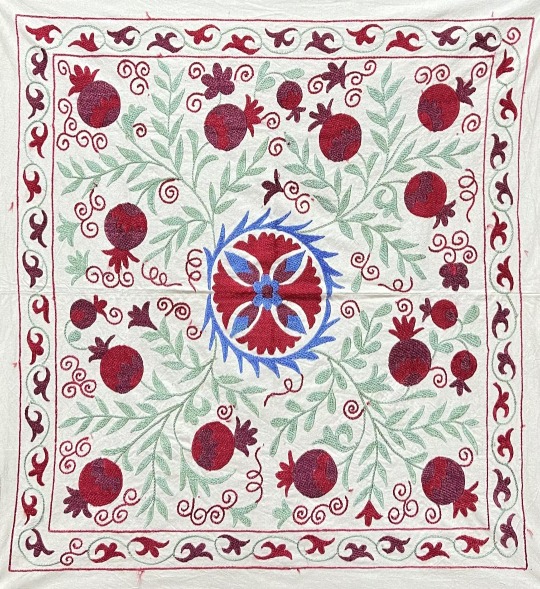
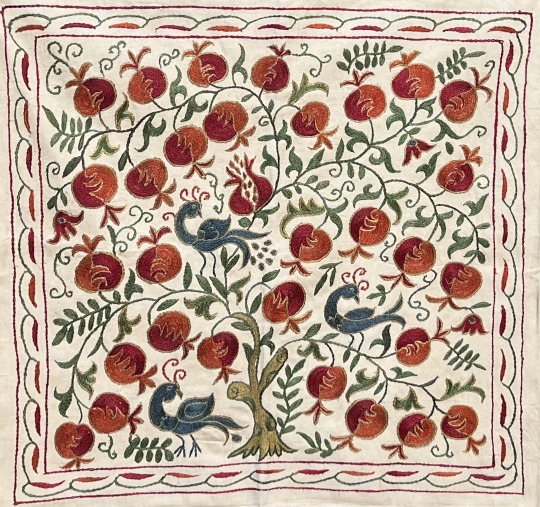
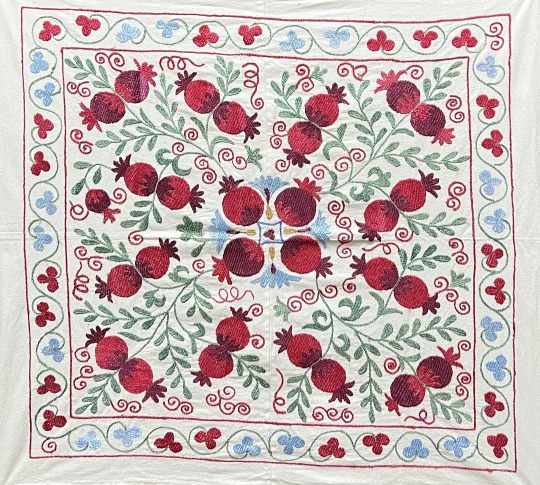
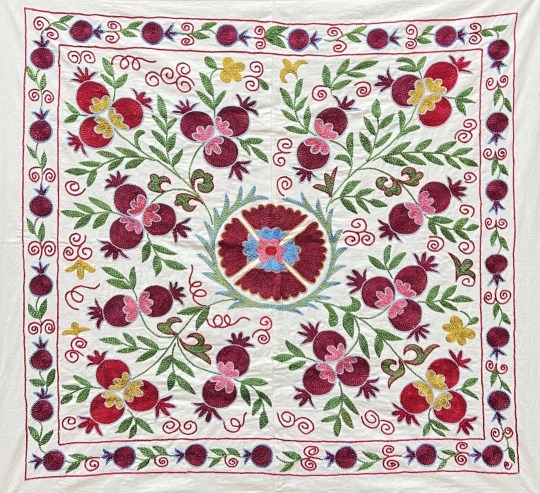
Uzbek Suzani textiles with pomegranate embroidery.
#uzbek#uzbek art#asian art#pomegranate#embroidery#textile art#suzani#uploads#central asian art#silk textiles#silk embroidery#traditional art#traditional craft#pomegranates
64 notes
·
View notes
Photo

19th-century Uzbek suzani cover, Richard Shapiro’s Malibu home | C Home · Lisa Romerein.
13 notes
·
View notes
Text

Antique urban suzani from the Emirate of Bukhara created by the Lakai, a rural Uzbek people, in the late 19th and early 20th centuries.
source: HALI125
pwlanier via semtituloh
3 notes
·
View notes
Text

Vintage yellow suzani from Uzbekistan with silk embroidery, 1960s-1970s
A suzani is a large, hand-embroidered textile panel; the word comes from the Persian word suzan, which means needle. Originating from nomadic tribes in Tajikistan, Uzbekistan, Kazakhstan and other Central Asian countries, suzanis have become highly collectable and valued for their beautiful decoration and fine craftsmanship.
47 notes
·
View notes
Photo

There is a FB page called Embroidery from Afghanistan that I recently ran across. I thought this was such a unique piece. It is a “dress made from antique Hazaran bodice and Uzbek suzani skirt for Westerners in Afghanistan, early 1970's. “
293 notes
·
View notes
Link

Are you searching for the best Suzani Fabrics? Explore our great diversity of styles, patterns & designs for your craft, upholstery & quilting products. Each handmade embroidery is original and good in its own prospective
0 notes
Link
Check out this listing I just added to my Poshmark closet: All Things Mochi Tribal Textile Tube Top Uzbek Collection OS New.
0 notes
